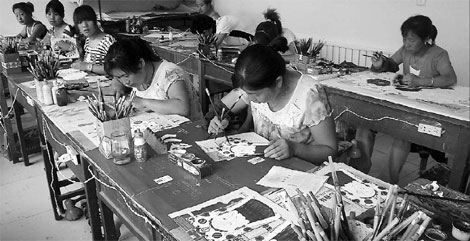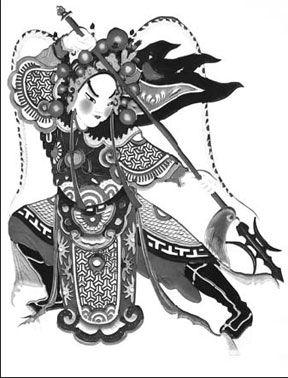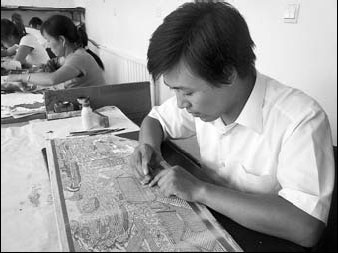


A village in Hebei province is spearheading the resurgence of a treasured folk art. Zhang Zixuan reports
Visitors to Nanzhangzhuang in Yuxian county of Hebei province, on first inspection, may find little that sets it apart from countless other villages in the country's north. Its residents continue with their age-old ways, greeting outsiders with the same innocent curiosity. But on second glance, one is bound to notice that even the most nondescript villager carries a business card. On it are the details of a family-owned, paper-cut workshop, alongside a colorful paper-cut pattern.
For centuries, Yuxian has been famous for its unique and vividly colored paper-cuts. Unlike most other paper-cuts found in the country, which are done by scissors and with paper of a single color, Yuxian paper-cuts are made with special knives, and are multi-colored.
This special technique is called "yin" cutting, wherein the artists use their knives to nick out small patterns, leaving more of the paper to paint on.
"Yang" cutting, which is what most other schools of this art form use, involves the cutting out of large portions of the paper, giving the paper-cuts a light, flimsy look.
Feng Jicai, chairman of the Chinese Folk Literature and Art Society, says that while many Chinese folk arts are dying, "the Yuxian paper-cut (art) is alive and flourishing".
 |
| A paper-cut featuring a Peking Opera figure done by folk artists in Yuxian county. |
More than 30,000 residents of 28 villages in Yuxian county are engaged in the paper-cut business.
While Nanzhangzhuang is not the only village where 80 percent of the residents live off the 200-year-old legacy, it stands out for nurturing the Zhou family, who owe their skills to the master teacher Wang Laoshang (1890-1951).
Both Wang and his able student Zhou Yongming (1928-1986), played a seminal role in the development of the Yuxian paper-cut.
At the workshop of Zhou Guang, Zhou Yongming's first son, one can find detailed introductions to the Yuxian paper-cutting technique, besides the works of his six siblings, his father Zhou Yongming and Wang.
"Yuxian paper-cuts were used as window decorations during Wang Laoshang's time," says Zhou Bing, 43, the youngest son of Zhou Yongming.
"People used to say it was an honor to place a Wang Laoshang-made local opera figure on the window to welcome the new year. They believed that looking at it was like watching a live local opera show."
It was Zhou Yongming who introduced innovative methods to make the color transitions of the paper-cut more smooth and natural.
His other significant contribution was his series of 100 Chinese opera masks, which have now become the representative image of Yuxian paper-cuts today.
"Peking Opera master Mei Lanfang once gave my father two tickets to his performance in 1957. That is when he became inspired and created the series," Zhou Bing says.
 |
| Liu Shu works on a large-scale paper-cut based on Along the River During the Qingming Festival, a famous painting of the Song Dynasty. |
They began to introduce more traditional as well as modern Chinese elements such as taichi, and ideas of environmental protection and social harmony, into their works.
Traditionally, it is the women who do the painting while men do the knife work.
Liu Shu, 23, who started to learn this art form when he was 16, is working on a section of Along the River During the Qingming Festival, a famous painting of the Song Dynasty (960-1279). Millions of tiny spaces that he needs to cut out are as small as rice grains.
"If I make a mistake with even one space, the entire piece will have to be abandoned," says Liu, who was chosen from among 1,568 candidates as the spokesperson for Yuxian paper-cuts at the recently held 1st Chinese Paper-cut Art Festival.
He uses various types of hand-made steel knives and says a large-scale work such as Along the River During the Qingming Festival will call for the use of more than 30 such knives.
"Our first lesson is in making these knives for they determine the quality of a craftsman," Liu says.
Another distinctive feature of the Yuxian tradition is the mass production of paper-cuts.
Once the draft pattern is ready, it is sewn together with 20 layers of Chinese xuan (rice) paper, which are first treated with a special kind of powder. The whole lot is then soaked in water and air-dried. This makes all the layers cling together, making for a thick piece of cardboard, which easily lends itself to the knife cutting.
Once the designs have been cut out, the layers are then separated.
Liu also demonstrates to visitors how the artists mix the paints with water and alcohol to create a myriad of different shades.
Clearly impressed, Francesca Valsecchi from Italy says, "It looks so easy, but is actually quite difficult.
"Getting to experience local art and culture rather than just buying nice souvenirs to take home, has made my trip in China so much more meaningful."
Referring to the popularity of the Yuxian paper-cut, Zhao Guangming, head of the Paper-cut Art Committee, Chinese Folk Literature and Art Society, says: "It combines multiple art forms such as designing, cutting and painting into one. Its resurgence offers hope for other folk arts."